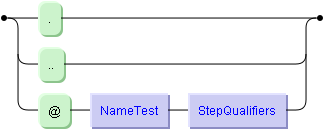Select context, parent, or attribute node using abbreviated syntax.

An AbbreviatedStep selects the context node, its parent node
or some attribute node by using abbreviated syntax. The symbol ..
is short for parent::node(). The symbol . is short
for self::node() if it is prepended by a path expression,
otherwise it is short for the context item. Similarly, @ refers to
the attribute axis and is the abbreviation for attribute::. It is
followed by a name test and zero or more predicate expressions, since the
corresponding rule (StepQualifiers) allows an empty predicate. The
child axis is the default axis, so that you can simply omit the
axis name in front of the element name
Select all books published after 1990.
input()/bib/book[./@year > 1990]
This is short for
input()/child::bib/child::book[self::node()/attribute::year >
1990]. Using "." to select the context node
is not necessary here, but merely emphasizes that it is the element node
book, where an attribute satisfying the predicate is
looked for.
Select all nodes that are parent of an element node
name.
input()//name/..
This is short for
input()/descendant-or-self::node/child::name/parent::node(). For
the patient database this retrieves all patient,
nextofkin and doctor
nodes, since they all have name as an element child
node.
Select all doctors with a pager.
input()//doctor[@pager]
This is short for
input()/descendant-or-self::node/child::doctor[attribute::pager].
The abbreviated step uses @ to select the attribute axis and then
checks for an attribute with the name pager
() and selects all doctor elements that have
an attribute node with the name pager
(NameTest with empty StepQualifiers).
Select all attribute nodes of all doctypes in the current collection.
input()//@*
Here, the name test following the "@" is a wildcard expression matching all of the selected kind of node.
Sort a sequence of numbers:
(3, 1, 2) sort by (.)
In this example . selects the context item.
The following construct(s) refer to this construct:
This construct is also related to the following construct(s):
NameTest
|
StepQualifiers
|